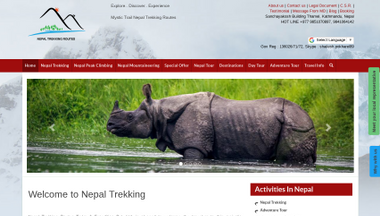2. Everest 2007
Kennedy’s words “You must do it not because it’s easy but because it’s hard,” are often met by a “why?” these days. On Everest only one off-normal route climb was attempted this year. Instead, there were even more reality shows made. Stories of thefts and failing oxygen continued; Everest Chinese side also offered armed guards patrolling BC and arrests of protesting Americans in preparation for the Olympic torch to be put on top of Tibet. Kazakh Vassily Pivtsov and Maxut Zhumayev summited Everest well ahead of any other foreign climber this year – without O2. The two top high altitude mountaineers were instantly criticized by amateur climbers for taking such a risk. Nives Meroi and Romano Benet also summited Everest via the North Col route without supplementary O2 support. This was their 10th, 8000er. Also Luis Felipe Ossa bagged an Everest summit without supplementary O2, becoming the first Colombian to do so. Those were the few no 02 ascents on the record 526 Everest summits in 2008.Seven people lost their lives on the mountain, by unclear causes. A 62-year-old Japanese collapsed shortly after starting descent. An Italian went missing without anyone noticing. Only two climbers died in actual falls – on the difficult SW face. Two high altitude rescues took place: Found almost unconscious on Everest south side at 8300 meters, with severe frostbite and altitude illness, Nepalese Usha was brought down by climbers from another expedition. On Everest north side, Italian mountaineer Marco Epis spent two days unconscious in the snow next to camp at 8300 meters. Unrelated Russian mountain guide Sergey Kofanov lowered him down to the North Col together with a Sherpa and a French female climber.At 71, Japanese Katsusuke Yanagisawa became the oldest person to summit the peak. At 18, Samantha Larson from California became the youngest 7 summiteer. A no arm attempt was aborted due to crowding and Dutch Iceman Wim Hof set a record by climbing to 7.400 meters in shorts.
3. AdventureStats about Everest, Solo and World Circumnavigation
Adventurestats analyzed all Everest statistics between 2000-2006 and found 12 facts countering popular misconceptions:- close to half of the climbers reach the summit;- two thirds are not part of commercial outfits;- independent climbers don’t die more often than guided climbers;- independent climbers fare very well on the south side normal route and on the off-normal routes, but less well on the north side normal route.- while the north side normal route has been deadlier than the south side normal route it seems to have little to do with technical difficulty: Everest climbers who tried off-normal routes (2000-2006) all survived the challenge;- Sherpas have a much lower death rate than other Everest climbers;- age is not a significant factor when it comes to fatalities or success on Everest;- climbing Everest without supplementary Oxygen brings half the success rate and twice the fatality rate;- climbers on oxygen died on more often on ascent, while climbers without oxygen more often died on descent. AdventureStats also ran specials on the true meaning of Solo and Earth Circumnavigation.
4. Himalaya spring 2007
In the past, the Polish were the underdogs. It made them the world’s hardest climbers, but far from the most known. Polish veteran Artur Hajzer 45, sat down with ExWeb to talk about old friends and changing times while in Himalaya while a bit away from Everest, “real” mountaineering kicked off.Korean 14×8000er summiteer Um Hong-Gil summited Lhotse Shar via its south face together with team mates Byung Sung-ho and Mo Sang-hyun, and one climbing Sherpa. This was a sweet success for Um, who was forced back on three previous attempts. Lhotse south has rejected some of the best climbers in history – including the Polish winter masters and Reinhold Messner.Spaniards bring a particular character to Himalaya. Self-sufficient, they avoid guided climbs, complicated logistics and supplementary O2. “8,000ers are only for those who deserve them,” they say. This spring, Spanish climbers were found on Kangchenjunga, Annapurna and Dhaulagiri. Iñaki Ochoa summited Dhaulagiri about 24 hours after setting off from BC. This was his 12th 8,000er. Kazakh Denis Urubko also reached the top of Dhaulagiri, after aborting his speed ascent to help another mountaineer. Other Dhaulagiri summiteers were Romanian Horia Colibasanu, Russians Serguey Samoilov, Svetlana Sharipova and Evgeny Shutov; Italians Gian Paolo Casarotto and Cristina Castagna, Swiss Joelle Brupbacher, German Richard Brill and Spaniards Josep Noguera and Roger Sellent. Horia Colibas and Inaki Ochoa continued to Annapurna, where they, Spanish Edurne Pasaban and Asier Izaguirre decided the conditions were far too dangerous and retreated. But Colombian Fernando Gonzalez Rubio, Ecuadorian Ivan Vallejo and Australian Andrew Lock summited – Annapurna becoming Andrew’s 12th, Ivan’s 13th and Fernando’s 5th 8000er. “I’m in awe of the climb, the conditions, our success and our survival and can say that this was the most demanding but rewarding 8000 meter climb I’ve done to date,” Aussie star mountaineer Andrew commented the Annapurna ascent. Things looked promising for Swiss Ueli Steck as he began his way up the tallest part of Annapurna’s mighty south face on May 21. But the gutsy solo, alpine style attempt was thwarted by a rock fall. Amical topped out Manaslu; Ralf’s 12th and Japanese Hirotaka’s 9th 8000er.
5. Himalaya spring fatalities
3 Spaniards, one Italian, a Slovak, two Koreans and a Nepali woman lost their lives in Himalaya (off Everest) in spring 2007 – six in falls and two in an avalanche.Italian Sergio Dalla Longa fell to his death on Dhaulagiri, only meters away from the summit. (Sergio’s brother Marco died on Nanda Devi in Indian Himalaya two years ago). Another summit attempt on Dhaulagiri ended in tragedy when Spaniards Santiago Sagaste and Ricardo Valencia were lost in an avalanche in C2. Slovak Dodo Kopold’s mate Marek Hudák was lost on Shisha Pangma; falling to his death only meters below the summit. Spaniard Iñigo de Pineda fell to his death from the upper sections of Kangchenjunga, while attempting to reach the summit together with team leader Oscar Cadiach.On the difficult side of Everest, Korean Oh Hee-Joon, 37, 10×8,000er summiteer and Lee Hyun-Jo, 34, fell to their deaths when attempting a new route on the SW face. The two went to Everest with Park Young-Seok (14×8000ers and both Poles) shortly after an attempt to cross the Bering Strait (aborted only 27 kilometers from land). Sherpani Pemba Doma fell to her death shortly after summiting Lhotse (partially shared route with Everest). Pemba was a celebrated female climber in Nepal, and a double Everest summiteer.
6. Karakoram
Where Nepal had been the hub of political unrest in 2006, climbers headed for Karakoram found themselves in political turmoil in 2007. Nilofar Bakhtiar felt forced to resign from her post after a fatwa was issued by Muslim clerics, who considered the female Minister of Tourism had committed an “un-Islamic” act by hugging a male coach after a parachute jump in France, where she was invited by the French Alpine club. Pakistan’s Prime Minister however rejected her resignation, “Nilofar is needed in the cabinet and should carry on with her duties,” Shaukat Aziz stated. A bloody clash between Army forces and Islamists bunkered up in Islamabad’s Red Mosque closed the Karakorum Highway. Later 12 persons were killed in a suicide attack in Islamabad. The year ended in tragedy when on December 27, Benazir Bhutto was shot dead in Rawalpindi.The troublemakers are a very small minority in Pakistan. The fight for democracy and peace will continue and New York Times best-seller Greg Mortenson urged climbers to keep coming: ”Climbers often ask me if it is ’safe to climb in Pakistan’. My answer is that over the last fifty years, about 250 climbers and trekkers have died in the mountains from accidents, injury and illness, and during that same period only three foreigners have been murdered in the northern areas.”Through all the unrest, debriefing sessions were on as usual at ACP; re-elected President Nazir Sabir told ExWeb he is hoping for the development of a Peace Park on Siachen Glacier as a joint effort with mountaineers from India.
7. The climbs
In the Karakoram mountains mostly Eastern European climbers shot for new routes on K2. Chinese female climber JiJi grabbed the summit of Hidden Peak for her husband Rena, who perished enroute there two years back. Austrian Gerlinde Kaltenbrunner summited Broad Peak – her tenth 8000er. Spanish Edurne Pasaban followed close behind: Broad Peak becoming her ninth 8000+ summit. Santiago Quintero, teaming up with Carlos Pauner, topped out BP as well, despite having lost all his toes to frostbite on a previous Aconcagua expedition. Italian Silvio “Gnaro” Mondinelli bagged his 14th 8000+ meter summit on Broad Peak, becoming only the 13th climber in the world to complete the dangerous quest and the third Italian, after Reinhold Messner and Sergio Martini. Moreover, Gnaro is only the 6th person to have made it without supplementary O2. Piotr Morawski, Peter Hamor and Josef “Dodo” Kopold reached the summit of Nanga Parbat following a fast and persistent attack. French climber and skier Jean-Noel Urban was on the peak as well, hoping the ski down following his spring Everest summit and some ski turns there. Unfortunately, Jean-Noel was turned back in exhaustion after having to not only climb, but also carry all his skiing gear up the snow-packed slopes of Nanga Parbat. Italians Karl Unterkircher, Daniele Bernasconi and Michele Compagnoni summited GII via the north spur, traversing down the south side and achieving the first complete ascent of the mountain’s north side. Earlier Karl Unterkircher and Hans Kammerlander summited the 7,350 meters-tall Jasemba on their third straight year attempting the peak. The two men climbed 2,000 vertical meters non-stop to the summit and back, in a 20-hour push.
8. K2
K2 kicked off with a remarkable joint international summit through the Abruzzi ridge. The Savage Mountain however defeated a number of all-star climbers trying to reach its top later on through the Cesen route.The Everest north side 2007 first summiteers Kazakhs Maxut and Vassily went for K2’s NW ridge but had to retreat after five days in high winds, an unclimbable rock wall, and chest-deep snow high above 8000 meters. The two surrendered only 100 meters below the summit. The ex-Soviet master climbers showed their true colors: Kozlov’s Russian team nailed the first ascent of K2’s West Face. Winning a formidable mind over matter battle, the climbers finally placed almost every member on the summit through the unclimbed, vicious face. All climbers went without oxygen. Kazakhs Denis and Serguey closed K2 on October 2nd in the first north side summit in 11 years, and the latest ascent of the peak ever. Denis Urubko now has 12 8000ers with only Makalu and Cho Oyu left for all the 14, 8000ers. Serguey Samoilov bagged his 5th 8000er summit (Manaslu twice). In true Kazakh style, the two men climbed alone on the mountain through a full blown blizzard and without supplementary oxygen.
9. Closing stats and fatalities
In 2007, Broad Peak had the most summits (77) followed by Spantik (44) and K2 (29). Nanga Parbat and the Gasherbrums shared 48 summits. With the new summiteers; Adventure Stats registered a total of 269 summits on K2, and 65 casualties, setting the death to summit rate on 24%. 23 of the mortal accidents on the mountain were due to climbers falling, a much larger number than those (13) who died in avalanches. In 2007, Korean team member Nima Nurbu from Thame fell to his death from the Bottleneck. Italian climber Stefano Zavka went missing after summit, last seen above the Bottleneck without means of communication. A total of 5 climbers perished in Karakoram this summer; two on K2, one on G1 and two on G2 in an avalanche which left Hirotaka Takeuchi injured.
10. Himalaya fall 2007
The fall Himalaya season sported very few summits due to serious weather. Shisha Pangma had a handful of summits via the south face, but was left unclimbed on the normal route. Except for that and Cho Oyu, only Jannu was summited, in a spectacular ascent. Valery Babanov and Sergey Samoilov (the Russian guide who rescued the Italian climber on Everest this past spring) reached the top of Jannu on October 21, placing a new route on the west ridge in alpine style. The final push took place after a night of heavy snow fall spent sitting out in the tent without sleeping bags at 7600 meters. Tomaz Humar performed a remarkable climb on Annapurna’s south side, solo and in Alpine style. Unfortunately, his accomplishment was initially shadowed by criticism, until fellow climbers came to his aid praising the ascent.Ski descents led to an ExWeb 8000+ ski/board mountaineering gear special: Stay warm and travel light was the message from Italian Emilio, Swedish Fredrik and American Tyler. Incredibly, all 8000+ climbers survived the fall Himalaya season, except for American Ray Yeritsian who suffered a ruptured artery in Nyalam (3750m) enroute to Shisha Pangma base camp.
11. Nangpa la – to be continued…
In a large Men’s’ Journal article titled “Murder at 19,000 feet”, details were printed about last year’s events on Nangpa La. “Paul told me you sent an email to ExplorersWeb,” Russell Brice yelled at Luis Benitez according to the article, “Are you fucking crazy?”“A climb without humanity is not a climb anymore,” Pavle Kozjek said, referring to Nangpa la. Word is there were shootings in the pass also this fall Cho Oyu season, but the rumor is unconfirmed. ExplorersWeb’s special story about Nangpa La and the upcoming Olympic Everest event spurred tons of emails. Meanwhile, another report showed that the battle between ambition and humanity continues on the commercialized 8000er mountains: ”At my usual rest spot, just below the big ice cliff, I saw a man hunched over sort of whimpering or crying,” Chris from Field Touring Alpine reported from Cho Oyu. “He told me he had just summited and that his partner had fallen and broken his leg while descending.”Chris spotted an unrelated expedition lowering the injured climber down a steep slope. He aborted his summit push and offered to help. “Alex (Abramov) handed me a rope and in his thick Russian accent said ‘you short rope him, keep head up hill’.” The rescue went on while many climbers, including a mountain guide walked past without a word and two supposedly ‘very famous’ alpinists passed going up without even turning their heads.
12. Medical, tech and science news
Spot Blanc? Neurologists at the University Hospital in Zaragoza, Spain, performed an MRI on a number of high altitude climbers. “Though the expedition suffered no major mishaps, only one of the 13 climbers returned with a normal brain scan,” said a New Scientist article. However, the climbers’ MRI scans actually were abnormal already before the Everest ascent – and unchanged after. More than anything, the study showed the importance of proper acclimatization – ignorance of which is still killing far more people than altitude itself. Live and let die on Everest: Bolivian/New Zealand medical doctor and mountaineer Erik Monasterio submitted a 4-year risk- and personality study of climbers and base jumpers: 1/3 of killed base jumpers died of other adventures or drugs/suicide. When confronted with uncertainty and risk both groups (climbers and jumpers) tend to be confident and relaxed; they are less responsive to danger; have good self-esteem and self-reliance and therefore tend to be high-achievers. As for trauma-related psychological complications; mountaineers had only 10-20% the rate of psychological disturbance to that experienced by fire-fighter and army personnel. Only 3% of mountaineers developed Post Traumatic Stress Disorder, whereas rates in firefighters are up to 20%. A psychological investigation released by The Lancet determined that intense stress but ultimately a massive boost to self-esteem awaits polar skiers. The experience breeds a long list of mental negatives, such as depression, anxiety, irritability, impaired cognition, intellectual inertia and a spaced-out condition called “Antarctic stare. ”The up-side is enhanced self-sufficiency, improved health and personal growth.Interestingly the study found a difference between Last Degree (short term) trips and the full (coast to pole) expeditions. Last degrees sports adventurous high-achievers, with low susceptibility to anxiety. Full trips require emotionally stable 30+ people who are rather introverted, with no great need for social interaction but also sensitive to the needs of others, and who would not become bored easily, the study concluded. BCMD Dr. Luanne Freer said that the Khumbu Cough is the biggest health problem on Everest’s south side. The cough is easily prevented: Check in at HumanEdgeTech for the hard to get JonaSport wire mesh facemasks now carried by HET. Global warming check: European winter no-show turned Daone Ice Master into a dry-tooling competition. The weirdest winter in decades with no snowfall and high temperatures forced the organizers to re-design the climbing wall to mixed dry tooling. Loads of snow was instead reported in western Himalayas and the Arctic Ocean sported frigid temperatures down to 50 below at the start of the skiing season. On Peak Lenin however the warming effect resulted in victims of the 1990 avalanche (43 international climbers trapped in camp at 5300 meters) surfacing in the melting glacier. Kazakh Alexander Chechulin reported his expedition had found a large number of bodies at 4200 meters. At HumanEdgeTech, Solar Blazt came back in stock, and new products were introduced such as new sat phones but also heat pads, face masks and other hard to find items for extreme exploration and climbing. A quick guide was published on what satellite phones to bring to the Seven Summits, and how to get smart with Thuraya charges. There was a big series on expedition technology including everything from filming HD on altitude, helmet cams, power and how to write great dispatches. Sat comm problems not acknowledged by the providers were frequent this year; the serious network issues suffered by Thuraya seems to be fixed however
.… 2008 preview
Chinese 1975 Everest climber Xia Boyu lost both his legs in un-selfish act on the mountain. Xia’s climbing spirit would get a serious reality check in the 30 years of hardship and pain that would ensue. Yet when a number of amputees began to scale Everest in recent years; Xia was urgently watching. The 55-year-old climber now wants to return to the peak; facing a challenge that may prove tougher than the climb itself: To find support and sponsorship in a political and financial climate not exactly famous for its interest in disabled people. Only three Americans have done it before – and no American woman yet: But next fall, American Tonya Riggs and high altitude filmmaker Brad Clement will take their chances on the highly dangerous Annapurna. The two recently summited Everest together. Nepal announced reductions in climbing fees off-season. Pakistan’s reduced climbing fees will continue in 2008. China will be strictly vetting each and every Everest expedition; 3 nationalities per expedition including Nepali staff are allowed, all documentation has to be sent at least two and a half months in advance, and only well organized, well supported and fully equipped teams will be allowed to climb is the word.Simone La Terra and Mehrban Karim have aborted their attempt for a winter ascent of Nanga Parbat. Simone Moro is once again teaming up with Shaheen Baig in an attempt to bag Broad Peak’s first winter ascent. A joint Kazakh/Italian team will depart on December 5, 2008, for a winter attempt on Makalu.The Himalayan Trilogy dream team (Piotr Pustelnik, Piotr Morawski and Peter Hamor) are coming back to Himalayas next spring. Over only 2 years; they plan the north-west face of Annapurna; a long G1/G2/G3 traverse; all Broad Peaks; a new route on the east face of Everest; the north face of Manaslu and the north-west ridge of Rakaposhi, “following the climbing spirit and dreams of my mountain guru, Woytek Kurtyka,” Piotr told ExplorersWeb.With only Everest left to go, Norbert Joos is the strongest candidate to become the next member on the 14×8000er list.March 6th 2007 Polish Tomasz Lewandowski kicked off his single-handed, non stop global voyage against the prevailing winds. The mega sail is a lifelong dream comes true, following a wrecked marriage, emigration to America, and fishing for money in New Bedford, the Kodiak Island, and the Bering Sea. Reid Stowe and Soanya Ahmad are on board the 70’ Shooner “Anne”, decided not to set foot on land for 1,000 days.Henk de Velde’s “Never-ending voyage” will do exactly that – never end. Erden Eruc’s voyage at least feels like it: Out in the middle of the Pacific, Erden has been rowing for 175 days now. Arctic expedition ship Tara is breaking free at last, after a 2 year long voyage across the North Pole.”Mars is not a first, it’s the beginning. We hope that the way we do it will throw Space wide open to you – our fellow explorers. That’s why, above all, we’ll fight to travel lightweight and cheap…” stated ExplorersWeb founders and set up a goal to travel to Mars in 2014. Lightweight explorers discovered the farthest corners of our earth and Space is next, that’s why we need – and must encourage – true adventure on Earth. So here is to all explorers in 2008: Believe in yourself and kick ass!
Happy New Year everyone!
* Explorersweb : Year-In-Review by Explorersweb.com
Filed under: wydarzenia | Tagged: climbing Everest, Events, highest mountains, Himalayas, K2, Karakoram, Krzysztof Wielicki |



























[…] arha_sekretariat article is brought to you using rss feeds.Here you will find the best trucking resources for truckers.“I’m in awe of the climb, the conditions, our success and our survival and can say that this was the most demanding but rewarding 8000 meter climb I’ve done to date,” Aussie star mountaineer Andrew commented the Annapurna ascent. … […]
[…] Original post by himalman […]
[…] Original post by himalman […]
[…] Highest mountains events in 2007. […]
Thanks for sharing these great thoughts. I’m bookmarking this for future reference. Some of these I already do, so the point resonated most strongly with me. Keep feeding the creativity.
I am currently on holiday so, for this reason, I’ve nothing better to do than surf the web for travel ideas, lie around and update my blog. Well, more or less anyway
Doug C
Nice site. Nicely laid out. I will be back for more information. Thanks and keep on with the keeping on.
[…] himalman wrote an interesting post today on Highest mountains events in 2007.Here’s a quick excerptIncredibly, all 8000+ climbers survived the fall Himalaya season, except for American Ray Yeritsian who suffered a ruptured artery in Nyalam (3750m) enroute to Shisha Pangma base camp. 11. Nangpa la – to be continued… … […]